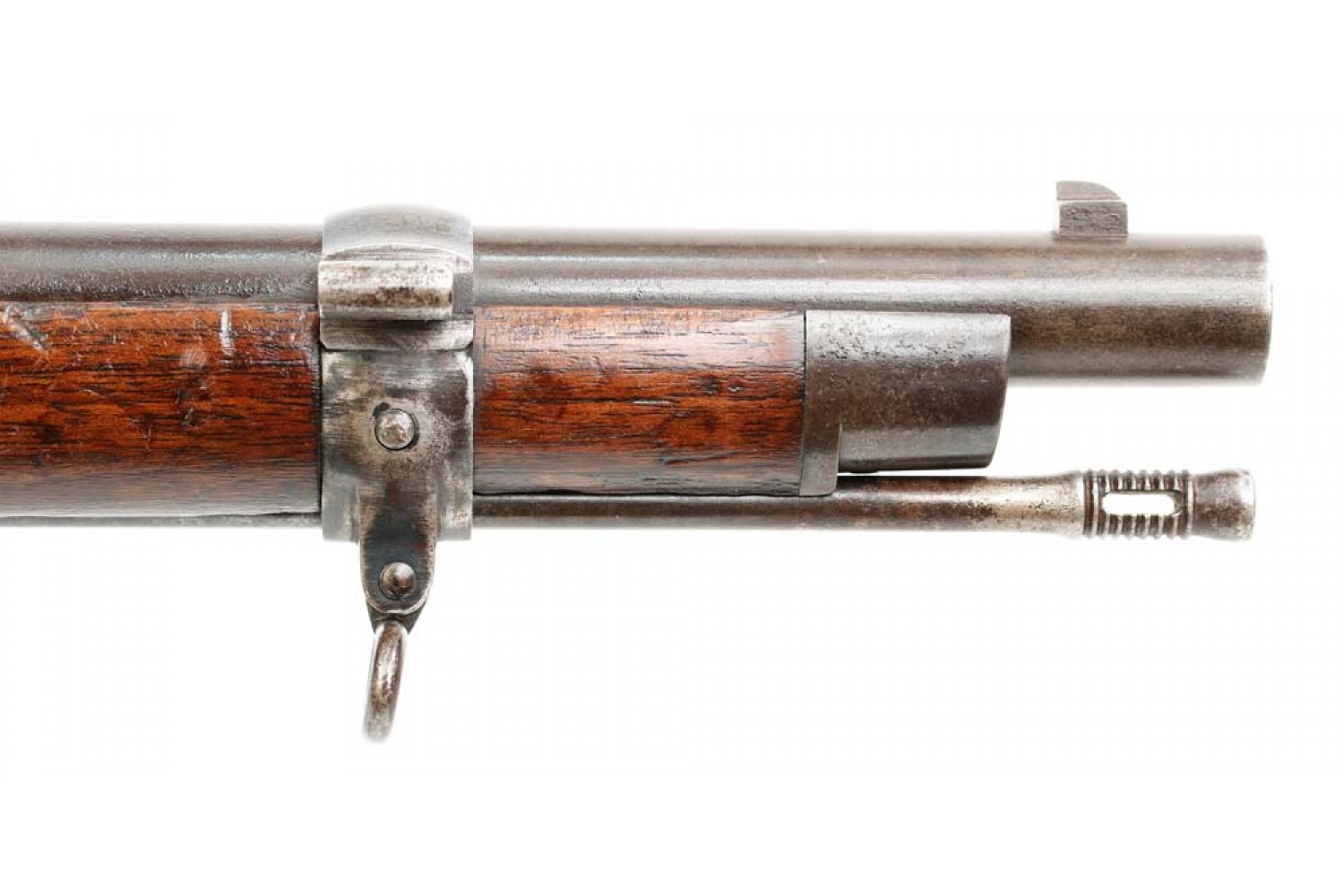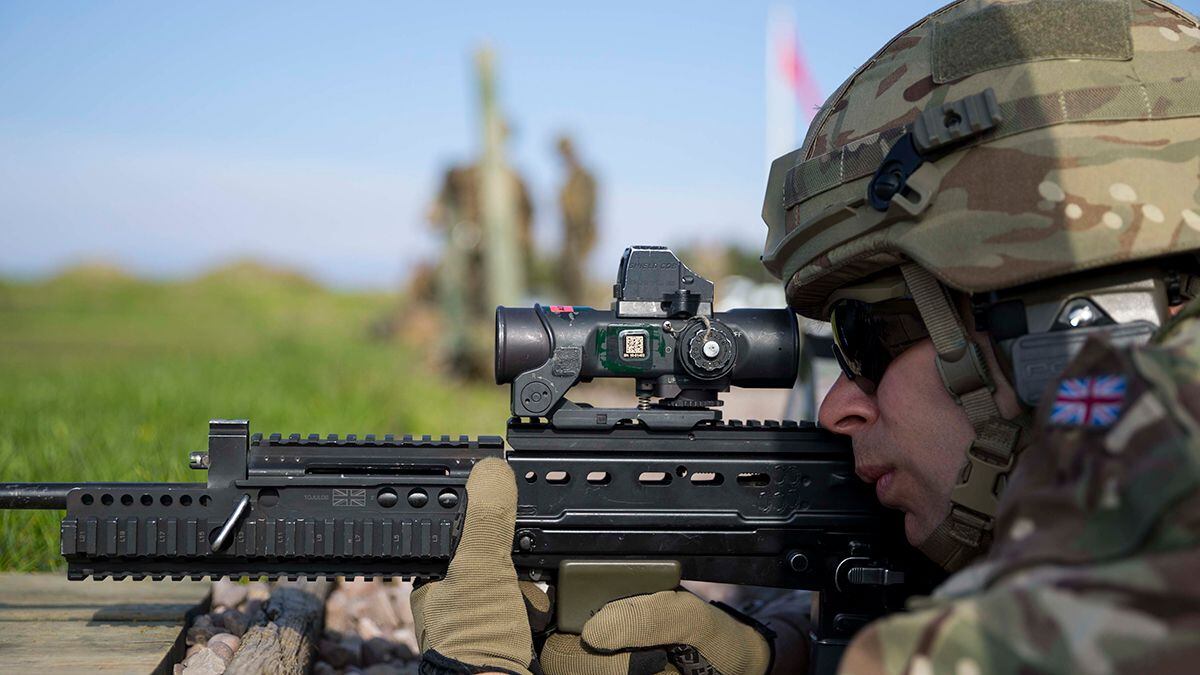British Military Rifles - The following is the current organization of the British Army Rifle Platoon until 2019. This organization follows the approval of the L85A3 in 2018, as well as other organization changes that are hot in the press (such as the removal of the L110A2 or FN Section-level Para minima). This information is based on feedback from service members and from relevant sources on the development of British Army doctrine. Contents:
[A] A MATADOR rifle and ATGM 1 NLAW that can be disposed of, or 2 NLAW, there is an area for each part of the weapon, but it is not assigned to any specific member. This replaces the AT4-CS, which is an interim replacement for the LAW 80. [B] The L7A2 is optional equipment to be issued depending on the situation. -------- → Alternate organization section
British Military Rifles

The British Army consists of one battalion headquarters and 3 artillery divisions. Although the basic platoon structure has remained the same since the removal of the exercise support unit in 2001, the detailed structure and equipment at the division level were updated in 2018 to 2019.
Soldiers In The British Army Marching With Their Rifles In A Welcome Home Parade Stock Photo
Platoon HQ consists of a platoon leader (lieutenant or second lieutenant), a platoon sergeant (sergeant), a signal/radio operator (private), and 2 runners (private).
Each weapon section consists of 8 handpicked workers. They each command a corporal who assists an active duty officer as the section's second-in-command (2IC). The unit was also split into 2 fireteams. The unit commander usually commands the Charlie Fire Team, while 2IC commands the Delta Fire Team.
Each fireteam consists of a squad leader, a gunner, a grenadier and a machine gunner or machine gunner or an additional machine gunner. All members are privates except the Section Commander and Section 2IC. The eighth man can be a machine gunner or, when the situation requires it, a heavy machine gun (more on this in the "Weapons" section). In armored personnel carriers mounted on Warrior IFVs, only 7 are typically dismounted with the gunner ejected.
While the unit lacks combat medics, with combat medics (CMTs) concentrated at the company level, every individual in the unit receives rudimentary combat rescue (CLS) training (MATT 3 BCD). Currently, one member of the unit is receiving more in-depth CLS training, called a "Team Medic".
Here's Why You Should Love The Sa80a2 Bullpup As Much As The Brits Do
The British Army's first new service rifle is the L85A3, introduced into service in 2018 to replace the L85A2. The A3 is essentially a modern upgrade package for the A2, intended to extend the L85's service into the 1920s. The rifle is usually equipped with an ELCAN SpecterOS 4× Light Daylight (LDS) with a small red dot sight (MRD) mounted on top. Each grenadier is also armed with an L123A1 40mm underbarrel grenade launcher, the British design for the Heckler & Koch AG36, also known as the M320 in US service. All troops in the unit, except the machine gunners, are armed with the L85A3, although the L85A2 may be in service with other units when decommissioned. The shooter is currently armed with an LMT-made L129A1 rifle in the United States.
After removing the L110A2 (FN Minimi Para) from the unit, the L7A2 was transferred from platoon headquarters to the gun sections and increased in numbers. The front line ammunition capacity of the L7A2 is 500 rounds for the gunner, 500 rounds for the 2IC section, and 1,000 rounds for each section. The rest is distributed as part of the Virtus delivery system. The barrel is not considered useful when working at sectional level. The gun is propelled by the bipod in this role. From a teaching point of view, this should not be regarded as L7A2 replacing L110A2. Instead, when the decision was made, it was sold as a substitute for volume and equality. The removal of the Minimis was justified by the strength of the L85A3 and L129A1 to provide more accurate fire on the Minimis, which in principle would reduce the volume of fire in relation to suppression. The L7A2 is considered the preferred drop-point weapon if units need the capability. For example, in armored weapons units, it has been noted that 7 reduction units can leave the L7A2 at home while having the support of their machine guns and guns. Alternatively, the unit can be organized into a conventional assault unit and an artillery unit, similar to the artillery unit and artillery unit established in the past. In this situation, 2IC will lead the weapons team which also includes the L7A2 gunner and sniper with the remainder under the command of the unit commander.
The unit is also authorized 1 MATADOR automatic rifle and 1 possible NLAW ATGM. The former gives the unit more protection and vehicle strength, while the latter can be thought of as a smaller javelin equivalent that allows the unit to attack heavy tanks and other vehicles. These weapons replaced the AT4-CS in British service, which itself was an interim solution which replaced the DOKA 80. In addition to the primary weapons and anti-personnel weapons, Section and 2IC commanders are now mostly armed with Glock 17 semi-automatic pistols.

Based on vehicles and machines, there are four types of infantry battalions in the British Army:
L85a1l: This Could Have Been The Ultimate Rifle. So What Happenned?
In the British Military Agreement 2020 "strong and strong, child-friendly and protected defense is the focus of Group 3. The department also includes the armored forces, which consist of the Challenger 2 main battle tanks and the Ajax-mounted armored cavalrymen Currently, the role of light protection and light movement is contained in Section 1. Additional unit types include light horses mounted on Jackals.
In addition to their duties as runners, troop headquarters runners may be tasked with operating quad bikes and trailers for platoon headquarters. Each group is allowed 1 Yamaha 450 Grizzly Quad Bike. The British Army Rumor Service — a bulletin board and comic site — describes him as a used version of a civil servant, 'because he's not working and he can't be fired'. The gun even has a decade embedded in his name. SA80 stands for "Small Arms for the 1980s".
Like many of the era, the SA80 represents a good era. Generals and Ministry of Defense officers wanted it to be the most effective and reliable weapon in the world.
Instead it was a bloody disaster. First introduced in 1985, the SA80 came in a bullpup configuration and fired the 5.56 x 45mm NATO round. It was intended to be a smaller and more technologically advanced replacement for the venerable L1A1 — rifle also known as the Fabrique Nationale FAL.
L1a1 Rifle Hi Res Stock Photography And Images
But problems plagued the SA80, which still works in a variety of configurations. To be fair, some British soldiers claim that the L85A2 — the more common assault rifle than the SA80 — is reliable most of the time.
However, earlier versions of the SA80 were renowned for their durability, especially under the extreme conditions found on the battlefield. Handguns often have "fragments" that break off or fall off the gun. There are even stories of fixed bayonets "going ballistic" when soldiers open fire.
But despite talk of replacing the weapon, the British Army plans to keep the SA80 at least until 2020 — whether the boys like it or not.

The development of the SA80 dates back to 1950. Even then the British Army was interested in developing a bullpup style weapon. But it wasn't until the 1970s that the UK built the original SA80 models.
British Enfield Bolt Action Rifle Hi Res Stock Photography And Images
At the same time, the US-made M-16 has become NATO's most common rifle, if only because of the sheer number of US troops in the alliance. The British still keep it in the colonel - it's a reliable and powerful weapon that served the army well in Malaya, Vietnam and the Falklands.
However, some soldiers view the FAL as a powerful weapon that doesn't keep pace with technological advances. For one thing, new rifles often include powerful low-light optics.
In the upper echelons of the British military there have long been complaints about the 7.62 x 51mm NATO FAL round. Many felt the round was too powerful for full automatic fire.
So the FAL's replacement — the SA80 — will use the same smaller round as the M-16. This will make it easier to supply equipment and ammunition and allow soldiers to check their weapons when firing automatics. Initial testing of the SA80 demonstrated that it is highly effective and battlefield ready.
Uk Small Arms Manufacturing
In 1990, Iraqi dictator Saddam Hussein invaded Kuwait and ignited the Persian Gulf War. British troops — armed with SA80 — rushed into Saudi Arabia and joined the attack. But the soldiers quickly discovered that their weapons had serious problems.
For example, the SA80 lacks a guard around the magazine release latch, which often causes the magazine to pop out when the weapon collides with the user's body. The designers built it for right-handed shooters — a great sight left-handed soldiers shooting a hideous rifle.
More surprisingly, the SA80 is also often clogged with dust

Military briefing template, military briefing topics, military briefing ppt, military briefing powerpoint, mission briefing military, how to give a military briefing, military briefing example, military briefing, military briefing powerpoint template, military briefing format, military mission briefing template, briefing
0 Comments